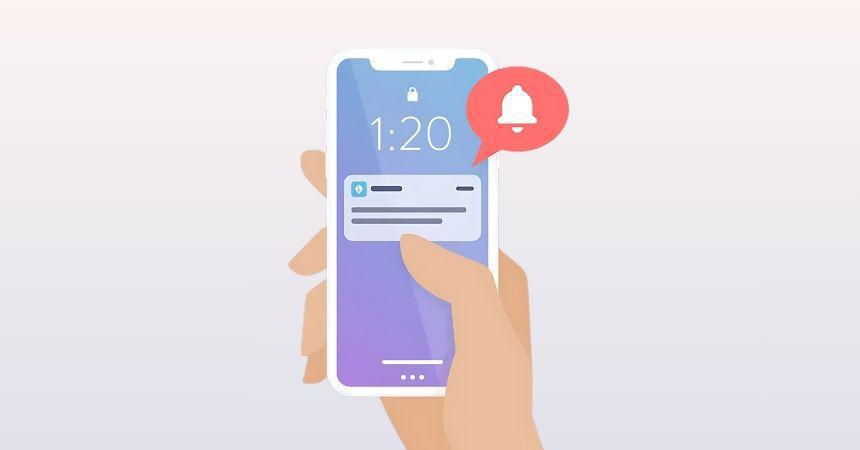In our mobile-centric world, effective user engagement is crucial. If you have an app, push notifications are a powerful marketing tool, but they must be used wisely. Misuse can lead to negative outcomes.
As the saying goes, “The good thing about notifications is they remind your users that your app is installed. The bad thing about notifications is they remind your users that your app is installed.”
In this article, we’ll share 6 best practices to maximize the value of your push notifications.
1. Timing & Frequency
Your app users receive notifications through sounds, vibrations, or both. Imagine receiving one at 3 am—this could anger users and lead to uninstalls. Most people only read the most relevant notifications, so your well-crafted message could get lost.
Timing is crucial when scheduling push notifications. The best times vary by industry: Monday and Sunday are generally good, while Wednesday between 3 pm and 4 pm is ideal for eCommerce, and Tuesday between 9 am and 10 am works better for media or bloggers. However, these trends change, so testing is essential.
Consider time zones when scheduling notifications to avoid waking users and to ensure time-sensitive offers are relevant. A well-timed push can greatly enhance user experience and app success.
While push notifications can effectively re-engage users, too many can be counterproductive. Avoid spamming users and send only relevant notifications. For a news app, frequent updates are appropriate, but for other sectors, be selective.
2. Valuable content
Segmentation First: The more tailored a push notification is to its audience, the higher its open rate will be. Segmenting is crucial. You can segment users based on in-app behavior or profile.
Segmenting by behavior provides valuable insight. For example, if a new user downloads your app but hasn't returned after browsing once, avoid flooding them with notifications. Instead, if a frequent browser hasn't made any purchases, you can increase the frequency of reminders about items they might want to buy.
Another strategy is segmenting by profile or preferences, like past purchases or set preferences. This allows you to align push notifications with user traits.
Combining behavior and profile segmentation yields better results. Push messages based on both types of data have an average click rate of 30.6%. After segmentation, personalizing and making the content relevant is key.
Relevant Content: "Push notifications go to people, not devices." Ensure your users see the advantage of your push notifications. For instance, if a user searched for a hotel but didn't book, sending a push like “Still going to NYC? Don’t miss out on new discounted rates at XYZ hotel!” will likely prompt them to open the app again.
Personalization: Adding the user’s name is a start, but more is needed. Show users that you understand their interests and preferences. While 25% of users may respond to being addressed by name, 58% find it makes no difference. Demonstrating knowledge of their preferences is more effective.

Push Notification Types: Welcome, Cart Abandonment, Promotional
Utilize different types of push notifications to keep users informed with relevant information. Common types include welcome messages, cart abandonment reminders, promotional offers, delivery updates, and the latest news.
Make it Visual: Adding images, videos, and emojis can make push notifications more engaging and effective. For example, emojis can increase click-through rates, with a CTR of 4.94% compared to 3.01% without them. Some emojis work better than others, so experiment to see what resonates with your audience.
Be Creative: Draft push notifications to feel like a conversation with your users. Personalize and engage them to make the interaction more meaningful and impactful.
3. Adapt to the devices
Follow Store Rules: Android and iOS have different notification interactions—tap to view on Android, slide to view on iOS. Keep notifications concise for readability:
- Android: 60-90 characters
- iOS: No more than 120 characters
Device Adaptation: Users react differently on each platform. Android has a higher opt-in rate (91%) compared to iOS (43.9%) because iOS requires active consent. Android users also process notifications differently due to the inbox that only clears manually.
Progressive Web Apps (PWAs): PWAs enable web push notifications, reaching users directly in their browsers, supported by most recent browsers. This allows contact with all users, regardless of device. However, some messages may be best targeted to specific user types, like encouraging web users to install the app.
4. Make sure they go where you want them to go
5. A/B testing
Testing your audience's reactions to various push notifications is essential. By A/B testing one variable at a time, such as a call to action, you can determine what works best. Analyze the results and adjust your strategy accordingly.
Set the right KPIs: Don't just focus on the push open rate. Also, analyze other KPIs like the opt-out rate and any app uninstalls to get a comprehensive view of your push notification effectiveness.
6. Opt-in
All these recommendations are useless if users don’t opt-in. How you ask for opt-in has a big impact on whether users say yes. The best approach is to ask permission softly and at the right time. Prime your users by explaining the benefits of push notifications and how they will enhance their experience.
Give users time to explore your app first. The average opt-in rate improves when users have completed more sessions in the app. Remember, you can only ask for official permission once on iOS, as Apple requires apps to ask upon install. Android automatically opts users in but allows them to opt-out later.
Both Android and iOS apps must allow users to turn off push notifications, either in the device settings or the app itself. Additionally, sending a dedicated email highlighting the value of opting in to push notifications can supplement your in-app efforts effectively.


